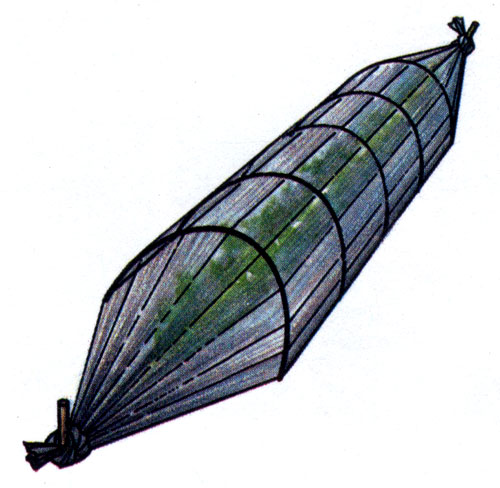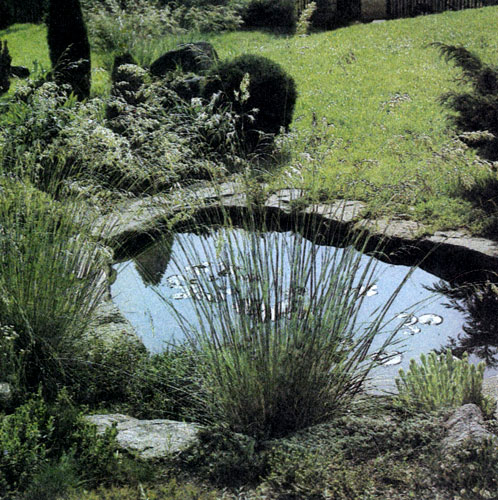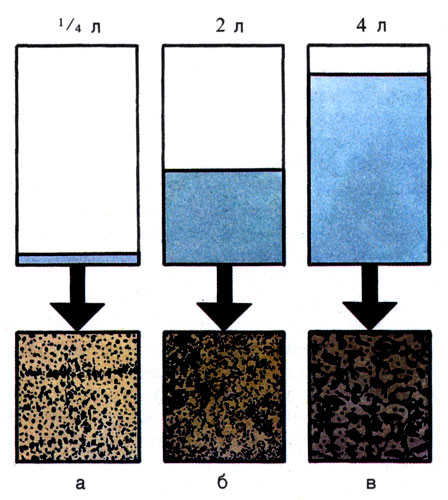Dependence of plants on environmental conditions
Every plant needs a certain environment for healthy development. The nature of this environment is fundamentally determined by climate, altitude and location.
Climate
Man cannot influence the climate. It can only modify the environment depending on the needs of plants, using irrigation, protecting plantings from the cold when necessary, creating shade, fumigating, etc., as a result of which the garden, garden, greenhouse or greenhouse is greatly improved called microclimate.
In order for the plant to develop well, all seasons are equally important. So, in winter, heavy snow or crackling frost without snow, ice formed or a sudden thaw can have both favorable and very undesirable effects on the future life of the plant. It is very important what spring will be like. The most ideal thing is when the snow melts slowly, the melt water is gradually absorbed into the soil, and does not flow in rapid streams into rivers and streams, as happens with rapid melting. From spring, we also expect that abundant rainfall at this time will establish the correct water regime and allow plants with a deep root system to develop well. Slow warming is also desirable without sudden changes in day and night temperatures. Then the trees will not wake up from their winter sleep ahead of time and will not suffer from frost. The optimal ratio between rainfall and temperature determines the successful development of plants in the summer and the good ripening of the crop. The sudden and premature drop in temperature below 0°C in autumn results in the wood of shrubs and trees not having time to mature properly. As a result, these plants will be more sensitive to low temperatures and less resistant to disease. Delicate varieties of vegetables and flowers will be destroyed by early frosts.
Location
For a garden, this is one of the decisive factors. It will depend on how the entire site is used. The slope on which the garden is located (south or north side) can, for example, increase or decrease the effect of winds, temperature changes, sunlight, etc. The southern slopes are most illuminated by the sun. They, as a rule, are also dry; in spring, plants begin to develop there earlier. The east side is also well lit, and most often it is even drier than the south, because it is dried up to a large extent by east winds. The western slopes are relatively warm, but wetter than the southern ones. The coldest side is the north. There, the soil thaws later, the plants are delayed in development. Some species generally develop poorly here due to lack of sunlight.
Much depends on whether the garden will be located in a protected or unprotected, open area. Windswept free space is usually dry. But in such a place, the wind often damages the plants. The most suitable areas for laying out a garden are those that are protected by forests or buildings on the north side or on the side of the prevailing winds. Closed places and cold hollows are not beneficial for crop production, since there is often fog here, the air is cold, and air masses move slowly.
Height above sea level
Altitude matters in terms of temperature, air humidity and rainfall. The higher the height, the less favorable the climatic and soil conditions are usually, the shorter the growing season. Basically, lowland, elevated and mountainous areas are distinguished (lowland - up to 250 m above sea level, elevation - from 250 to 450 m and mountainous terrain - from 450-600 m and above).
Since, when planting a garden, we usually do not have the opportunity to choose a site that would be ideal in terms of its location and climate, then we have no choice but to proceed from reality and try to adapt to it. First of all, this means choosing the right crops correctly. There is a whole scale of plants with very different environmental requirements: from plants that are extremely moisture-loving to extremely dry-loving, from light-loving to shade-loving. By choosing suitable crops and varieties, you can fully use the conditions available on the site. In order to neutralize the prevailing winds, appropriate means of protection should also be chosen, whether it be rocker planting of trees or the erection of various walls that will simultaneously perform a decorative function or visually divide the space. If the soil is too damp, it should be drained, and excessively dry, on the contrary, will have to be abundantly moistened. In areas that are too sunlit, shade can be created using appropriate plantings. Artificial reservoirs will help to make the microclimate more humid.
There are many opportunities to mitigate unfavorable conditions. Using them, the gardener will be able to grow a garden both in mountainous areas and in less suitable conditions, in which something will bloom and bear fruit from spring to autumn, fully endowing the owner with both its beauty and its fruits.
climatic factors
The complex of climatic conditions creates favorable or unfavorable conditions for plant life. These are mainly lighting (intensity, length of daylight hours), temperature, moisture (amount and distribution of precipitation) and its content in the atmosphere.
Light
Plants have different requirements for the amount of light. According to this criterion, we divide them into light-loving, penumbra and shade-tolerant plants. Light-loving plants grow well only in sunny places. Those that love partial shade need partial shading or the so-called "diffused light", and shade-tolerant plants can be planted in the shade. Different cultures for their flowering and fruiting require different lengths of daylight hours. Therefore, they are divided into short-day plants (an example is chrysanthemums, which need daylight hours not exceeding 12 hours for flowering), medium-day plants (say, roses that are not too demanding on the duration of lighting and bloom at a time when daylight hours fluctuate within 12 hours) and long-day plants (for example, carnations that require daylight to last more than 12 hours).
Light is of great importance for the growth and fruiting of plants, since it has a significant effect on the intensity of the metabolism taking place in plant tissues. The gardener must strive to ensure that the crops grown have enough light. Specifically, this means planting plants in optimal combinations so that they do not shade each other. It is also necessary to thin out the crowns of trees in a timely manner, so that light penetrates deep into the foliage, making colorful and ripening fruits.
Temperature
Most of the plants of the middle band begin their vegetation at a temperature of 1-5 ° C, which is the temperature minimum. At temperatures above 40 ° C, plants begin to die, so this limit is called the temperature maximum. The most suitable (optimal) temperature for most plants in the middle zone is in the range of 20-30 ° C.
Especially dangerous for plants are early autumn frosts and late spring frosts. Autumn frosts usually destroy all flowers and vegetables at once. Late frosts in spring damage vegetable and flower seedlings, flowering fruit trees and ornamental shrubs. The gardener is constantly threatened by the danger of the so-called "May cold", which happens in mid-May. Only after the last breath of winter can heat-loving plants (tomatoes, peppers) be planted without fear.
Temperature fluctuations are especially dangerous in the pre-spring period, when on sunny days the mercury column rises above 10 ° C, and at night there is a strong cooling. The resistance of individual plant species to low temperatures determines the possibility of their cultivation in certain places. Therefore, success in growing any garden plant primarily depends on whether the crop is chosen correctly and whether a suitable place is found for it on the site. Where the choice was made erroneously, where the place does not meet the needs of the plant, it is better not to plant it. In extreme cases, the prepared garden bed must somehow be protected, improved, taking into account the requirements of the culture. You can protect plants with the help of erected walls or shelters made of plastic film or glass.
Moisture
Without water, there is no life, and there are no plants. Water provides them with direct nutrition in the form of oxygen and hydrogen, in addition to dissolving the nutrients that enter the plant through its root system. With a lack of moisture, wilting occurs. Any plant for its existence needs a sufficient amount of water that meets its needs throughout the growing season - from germination to fruiting. Depending on the need of a particular crop for water, they are divided into aquatic, water-loving, plants with an average need for moisture and dry-loving.
Aquatic plants grow right in the water, their roots penetrate the layer of silt at the bottom of the reservoir (an example is a white water lily, which is also called a water lily). Water-loving plants need not only an abundance of soil water, but also moist air, so they can be bred most often in a greenhouse, where they have to create a special microclimate. Most plants need an average amount of water. In arid places, dry-loving plants grow with fleshy stems or leaves, where moisture accumulates for the period of drought (cacti, young, etc.).
The main source of moisture is precipitation: rain, snow, frost, dew. Rain is the most important and most abundant source of moisture during the growing season. Snow forms a thick blanket that protects plants from frost in winter, and in spring, melting and soaking into the soil, creates a source of so-called winter moisture. Hoarfrost is small ice crystals that form on the surface of soil and plants from moist air as a result of cooling when the temperature drops below 0 ° C. During the day, when it gets warmer, it melts, and moisture flows into the soil. Hoarfrost appears, as a rule, before sunrise in cold autumn and spring. Dew is also a source of natural moisture, especially when there is no rain. It is formed, like frost, from water vapor as a result of air cooling at night and settles in the form of water droplets on the surface of plants and the ground.
During the year, the amount of precipitation is unevenly distributed. Most of them happen in autumn and spring. In order for the plants to receive moisture in sufficient quantities and at the right time, they must be watered.
Air
Air is a mixture of gases and water vapor. For plants, it is a source of oxygen and carbon dioxide, and for those organisms that are able to bind the nitrogen in it, it is also a source of nitrogen. Humidity has an effect on evaporation. If the air is too dry, evaporation increases greatly and the plants suffer from a lack of water. With excessive humidity, the plants begin to rot, which leads to the development of fungal diseases. High air humidity is usually encountered only when growing crops using a glass or film cover. Therefore, in such cases, one must not forget about ventilation.
Polluted air is harmful to all living things - for people, animals and plants Ashes, soot and dust settle on plants, mainly on their foliage. This precipitation clogs the stomata, absorbs the sun's rays and prevents the leaves from performing their important functions. Sulfur dioxide contained in smoke is especially harmful, as it decomposes chlorophyll. All this has an adverse effect on the overall growth and development of plants.
A slight movement of air, a light breeze have a good effect on vegetation, however, sharp movements of air masses, a strong gusty wind, a storm are not good for the plant; they can damage, break, and even uproot it from the ground. In addition, in windy weather, evaporation increases sharply: both the soil and plants dry out. The raging wind also affects pollination to a small extent, keeping the bees from flying out and causing the stigma to dry out. From strong winds, most often blowing in one direction, plantings can be protected by a strip of suitable rock plants or by placing more tender crops under the reliable protection of a nearby wall, etc. A hedge wall of fruit trees should also be planted in such a way that the wind does not hit her at close range, and slid along.
The soil
The soil can be perceived as a living being, in which the life of various bacteria and other microorganisms is in full swing, mold grows. In the soil - a vicious circle of life and death, formation and decay of organic compounds. She, like any living organism, strives for a single goal: to live and multiply.

Soil is the top layer of the solid earth's crust. The part of the soil cultivated by agricultural machines and implements is called arable land. Clays found in places are biologically of little value. Gardeners do not work with them, leaving them to potters and stove-makers.
Under the top arable layer of soil is a thinner layer called the base. Even lower lies the subsoil horizon, and then there are the parent rocks. The term soil profile refers to the topsoil, base and subsoil horizon.
Soil is made up of various constituents, mainly solid particles, water and air.
Solid particles are actually the soil mass itself, consisting of substances of inorganic and organic origin. The inorganic part is dominated by sand, dust, and clay particles of different sizes. The smallest particles of clay have the ability to retain water with nutrients dissolved in it and glue the soil into larger lumps. Its organic part consists mainly of humus and soil fauna. Humus occurs as a result of the decomposition of organic matter. This process is a consequence of the vital activity of soil fauna, primarily bacteria.
The decomposition of organic matter in the soil is called humification. Depending on the degree of air access (mainly oxygen), humification occurs by smoldering, rotting or pickling.
Smoldering is the decomposition of organic substances with sufficient air access. Bacteria decompose organisms and release mineral compounds necessary for plant nutrition. Such a process is considered favorable. Decay is the decomposition of organic matter by bacteria in the absence of air. This is an unfavorable process. Fermentation is the conversion of sugar and other non-nitrogen-containing substances into fermented foods and carbon dioxide. Fermentation occurs with the participation of yeast with limited air access.
Depending on the content of humus, there are soils with little humus, having less than 1% humus, moderately humus (1-2%), medium humus (2-3%) and humus (more than 3% humus). The soil in the garden should have at least 3% humus.
The space between the individual solid particles of the soil is filled with water and air. Various substances are dissolved in the water, so it is not so much water as a nutrient soil solution. The air in the soil contains more carbon dioxide than atmospheric air. This is because the roots of plants breathe, consuming oxygen and releasing carbon dioxide.
plant growth
The growth rate of different plants is very different. Mushrooms grow fastest of all, grasses (including sunflowers) grow very quickly in size, trees grow slower. Different organs of plants do not always grow in the same way and evenly. At first it happens slowly, then there is an acceleration that continues until a maximum is reached, and then the whole process subsides and finally stops. Plants grow as they grow, both in height and in width.
The life of higher green plants - from beginning to death - is the same. Flowering plants develop from seeds. A ripe seed first rests, its life processes are minimized, but, once in favorable conditions (sufficiency of moisture, heat, light and oxygen), it awakens, germinates and begins to develop into a plant. It receives the energy necessary for this by decomposing the stock of substances that are in itself, as well as drawing water and oxygen from the environment.

When the plant reaches puberty, flowers will appear on it, from which, after fertilization, fruits with seeds will develop. However, in the later life of plants, differences arise between those that bloom only once (annual and biennial), and those that bloom repeatedly (perennial herbaceous plants and tree species). The first ones, after the formation of seeds under our conditions, perish, and their life will continue in new plants that will germinate from seeds. Perennial plants develop, bloom and bear fruit for a long time until they die. In addition, many plants reproduce vegetatively, with their different parts. The most hardy parts of some plants can survive a period of adverse living conditions, and then give new shoots, thus continuing their further growth.

